What is a "pit bull"?
"To make words serviceable to the end of communication, it is necessary... that they excite in the hearer exactly the same idea they stand for in the mind of the speaker... Where shall one find any, either controversial debate, or familiar discourse... wherein it is not easy to observe the different notions men have of [words]?... The greatest part of disputes [are] more about the signification of words than a real difference in the conception of things..."
- John Locke, An Essay Concerning Human Understanding, 1690 |
More than three centuries ago, John Locke observed that many debates hinged on definitions of words. This phenomenon can be seen with crystal clarity in the controversy that swirls around the "pit bull." There is no single, uniform, agreed-upon definition or description of a pit bull. People who insist that the pit bull is an inherently vicious devil-dog cannot find common ground with those who believe the dog is an angel in disguise. Consequently, I see no end to the debate.
Rather than attempt to put forth my own singular definition of a "pit bull," in this essay I will attempt to describe the myriad definitions that exist. My hope is that, by pointing out the differences in definitions, people can better understand other points of view, thereby improving communication and eventually finding a common ground from which to begin real conversations.
It is critical to understand that the "pit bull" is NOT a breed. A pit bull is a type of dog, just as the words "retriever," "terrier," or "shepherd" describe a certain type of dog, not a breed. The term "pit bull" has no single, solid, scientific definition. What you consider a "pit bull" is not likely to be identical to the concept retained by any other person.
Table of Contents
We will examine the various definitions momentarily, but first, let's set the scene for these definitions by describing the pit bull's history.
History of the Pit Bull
The Molossus, a large, mastiff-like, war dog, is the ancient ancestor of a number of large breeds. The Molossus seems to have originated in Greece and made its way to Britian via trading ships. The huge war dog also impressed the Romans, who brought them from Britain into other areas of Europe.
From the Molossus descended a variety of dogs, including Mastiffs, Bandogs, Alaunts, and the pit bull's predecessor, the Bulldog - so named because they were used to catch and hold bulls for the butcher to slaughter. Blood sports, including bull and bear baiting, gained in popularity over time until they became grand events. The Humane Acts of 1835 in England put a stop to bullbaiting, and dog fighting quickly became the new "sport" for Bulldogs.
Most breed researchers believe that the pit bull-type dog was created by crossing a bulky Bulldog with a smaller, faster Terrier, resulting in a Bull-and-Terrier, which was said to excel at dog fighting because it possessed the strength and tenacity of a Bulldog with the speed and determination of a Terrier.
Over time, the Bull-and-Terrier evolved into the Staffordshire Bull Terrier, which, when brought over to the United States, eventually became the American Pit Bull Terrier. The UKC (United Kennel Club) was the first major national kennel club to register the American Pit Bull Terrier. The AKC (American Kennel Club) followed suit years later, but they changed the name "American Pit Bull Terrier" to "Staffordshire Terrier", and later to "American Staffordshire Terrier" (to distinguish it from its English cousin, the Staffordshire Bull Terrier).
Development of the Most Common "Bully" Breeds

Sources include: www.bulldoginformation.com, The World of Fighting Dogs by Carl Semencic, Atlas of Dog Breeds of the World by Bonnie Wilcox, DVM, Encyclopedia of Dog Breeds by Ernest Hart.
The American Staffordshire Terrier is effectively the AKC show version of the APBT. In general, both AST and APBT breeders deny that the breeds are anything alike anymore. The AST is typically bred for appearance and conformation, while the APBT is in many cases bred for function. (By function, I do not mean that APBTs are solely bred for skill in dog fighting. Function-bred dogs can be bred for skill in hunting, weight-pull, Shutzhund, agility, service, and much more.) Breeding for function rather than appearance often results in a wide variety of sizes, colors, and body styles.
Don't get caught by "bull" confusion! There are a number of breeds that carry the label "bulldog" or "bull" in their breed name. The American Pit Bull Terrier and the Staffordshire Bull Terrier are just two such breeds. "Bully" breeds also include the French Bulldog, English Bulldog, Bull Mastiff, Bull Terrier, Olde Bulldogge, American Pit Bull Dog (not Terrier), and American Bulldog. These breeds are not all the same, nor are they all "pit bulls"! They are different breeds with different history, temperament, and appearance. |
Back to Table of Contents
Definitions of the Modern Pit Bull
Technical Definition
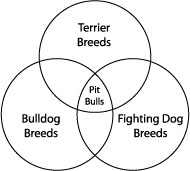 Literally, the term "pit bull terrier" (from which comes the shortened term "pit bull") can be broken down into three components: "pit," "bull," and "terrier." "Pit" acknowledges the dog's history as a fighting dog (because dogs fight in "pits") while "bull" highlights the dog's bulldog ancestry and "terrier" describes the dog's terrier ancestry (see the graph and history section above). It is important to note that not every fighting dog is a Bull-and-Terrier, and not every Bull-and-Terrier is a fighting dog. The three elements (Bulldog, Terrier, fighting dog) come together only in the pit bull type dog.
Literally, the term "pit bull terrier" (from which comes the shortened term "pit bull") can be broken down into three components: "pit," "bull," and "terrier." "Pit" acknowledges the dog's history as a fighting dog (because dogs fight in "pits") while "bull" highlights the dog's bulldog ancestry and "terrier" describes the dog's terrier ancestry (see the graph and history section above). It is important to note that not every fighting dog is a Bull-and-Terrier, and not every Bull-and-Terrier is a fighting dog. The three elements (Bulldog, Terrier, fighting dog) come together only in the pit bull type dog.
"Pit bull" does not include all bully breeds or all fighting dogs. Akitas are a fighting breed, but they are not a bully breed, so they are not pit bulls. Bull Terriers are Bull-and-Terrier type dogs, but they were never used consistently for dog fighting, so they are not pit bulls. The Dogue de Bourdeux might be considered both a Bulldog breed and a fighting breed, but the Dogue de Bourdeux has Mastiff, not Terrier, in its ancestry.
Thus, in a technical sense, "pit bull" refers to a dog whose ancestors were Bull-and-Terrier type dogs once used for dog fighting. The specific breeds included in this technical definition are: American Pit Bull Terrier, American Staffordshire Terrier, and Staffordshire Bull Terrier. On this website, I use the technical definition of "pit bull," with some exceptions as noted.
The three technical pit bull breeds
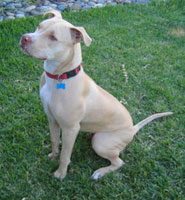 |
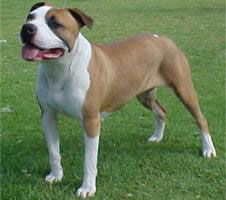 |
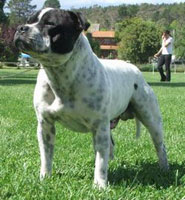 |
American Pit Bull Terrier
|
American Staffordshire Terrier |
Staffordshire Bull Terrier |
In the United States, the American Kennel Club (AKC) registers American Staffordshire Terriers and Staffordshire Bull Terriers. The United Kennel Club registers American Pit Bull Terriers and Staffordshire Bull Terriers. Their breed standards can be accessed at the following links:
UKC American Pit Bull Terrier
AKC American Staffordshire Terrier
AKC Staffordshire Bull Terrier
UKC Staffordshire Bull Terrier
The American Staffordshire Terrier and American Pit Bull Terrier have very similar appearances, to the point that some APBTs are actually dual-registered as ASTs. APBTs and ASTs should be no more than 65 lbs at a healthy weight. The Staffordshire Bull Terrier is a smaller dog and should weigh between 28 and 48 lbs. In all cases, the dog's overall body shape should be proportional and fairly streamlined; no part of the body should look "oversized."
Pit bull temperament
A dog's breed or type is not solely defined by its appearance; temperament must also be considered. The pit bull's proper temperament is usually described as one of confidence, determination, courage, and tolerance.
Pit bulls were historically bred for dog-aggression, not human-aggression. Before a fight, dog handlers washed each other's dogs. In the heat of a dog fight, handlers had to be very close to their dogs, sometimes with their face just inches from their dog's face. Dogs that redirected their aggression toward people were culled (killed), with very few exceptions. Overall, this should have created a breed-type with a very stable temperament.
This is reflected in the breed standards' descriptions of proper temperament. It is important to note that none of the breed standards allow for viciousness or human-aggression. Dog-aggression is acceptable to some extent but the dog should never be unmanageable.
Back to Table of Contents
Legal Definition
Breed-specific legislation (BSL) requires that all dogs be classified as a particular breed or type of dog. BSL almost always includes "pit bulls" as a specific target of the legislation. Because the term "pit bull" does not mean the same thing to everyone, a legal definition of "pit bull" is usually necessary in order to clarify exactly which dogs are affected by the legislation. Additionally, court cases revolving around BSL typically hinge on whether the definition of "pit bull" is too vague or incorrect.
Who creates this definition?
Breed-specific legislation, and thus the legal definition of "pit bull," is created by lawmakers (state legislators, city councilmembers, and so forth), sometimes with input from other sources (animal control, citizens, laws written by other legislators, etc.) and sometimes based solely on the lawmakers' own concepts of what a "pit bull" is. For this reason, the legal definition of a pit bull can differ significantly from the technical definition.
Here are some examples of differing legal definitions of the term "pit bull":
Denver City Code, Sec. 8-55.b.2:
"A 'pit bull,' for purposes of this chapter, is defined as any dog that is an American Pit Bull Terrier, American Staffordshire Terrier, Staffordshire Bull Terrier, or any dog displaying the majority of physical traits of anyone (1) or more of the above breeds, or any dog exhibiting those distinguishing characteristics which substantially conform to the standards established by the American Kennel Club or United Kennel Club for any of the above breeds..."
Denver's city code is the most commonly imitated legal definition. Although Denver uses breed standards to identify pit bulls, they focus entirely on physical characteristics and conveniently ignore the temperament characteristics mentioned in the breed standards. |
Ontario, Canada Dog Owner's Liability Act:
"'pit bull' includes: (a) a pit bull terrier, (b) a Staffordshire bull terrier, (c) an American Staffordshire terrier (d) an American pit bull terrier, (e) a dog that has an appearance and physical characteristics that are substantially similar to those of dogs referred to in any of clauses (a) to (d); ("pit-bull") "
Ontario Attorney General Michael Bryant offers this definition to the Ontario legislature:
"I've said before and I will say again, if it walks like a pit bull, if it barks and bites like a pit bull, wags its tail like a pit bull, it's a pit bull.” (Ontario Hansard 38-1, November 4, 2004)
In a 2007 court decision about the Act (Cochrane v. Ontario), the Judge noted: "...by providing that 'pit bull includes' and by designating 'pit bull terriers', the definition captures dogs beyond these three breeds and beyond those that are substantially similar in appearance and physical characteristics to these three breeds." |
Alburnett, Iowa, City Code 17.2:
A dangerous dog is defined as: "Pit bulls, including the following:
1. The Bull Terrier breed of dog,
2. The Staffordshire Bull Terrier breed,
3. The American Staffordshire Terrier breed,
4. The American Pit Bull Terrier breed,
5. Dogs of mixed breed or other breeds which are know [sic] as pit bulls, pit bulldogs or pit bull terriers,
6. Any dog which has the appearance and characteristics of being predominately of the breeds of Bull Terrier, Staffordshire Bull terrier, American Pit Bull Terrier, American Staffordshire Terrier, and other breed commonly know [sic] as pit bulls, pit bull dogs or pit bull terriers or a combination of any of these breeds."
This city code includes Bull Terriers, a dog which is not technically a pit bull and, I would add, not commonly known as a pit bull except by the sadly misinformed. |
New Jersey bill S801 proposed by Senator Sharpe James in 2007 (did not pass):
"'Pit bull' means any dog of the breed American Pit Bull Terrier, American Staffordshire Terrier, Staffordshire Bull Terrier, or Staffordshire Terrier, or any dog determined to be a pit bull type dog pursuant to subsection c. of section 3 of this act... A municipality adopting an ordinance pursuant to subsection a. of this section may require the license applicant to provide: (1) information about the breed, sex, age, color and markings of the dog and whether it is of a long- or short-haired variety..."
Senator James apparently was unaware that 1) there is no such breed as "Staffordshire Terrier," and 2) unlike some breeds (i.e. Dachschunds and Chihuahuas), pit bulls simply do not come in a "long-haired variety." |
State of Ohio Code 955.11:
"'Vicious dog' means a dog that, without provocation and subject to division (A)(4)(b) of this section, meets any of the following:...Belongs to a breed that is commonly known as a pit bull dog. The ownership, keeping, or harboring of such a breed of dog shall be prima-facie evidence of the ownership, keeping, or harboring of a vicious dog."
The state of Ohio does not even bother to define "pit bull dog," assuming that any breed "commonly known as a pit bull"—is a pit bull. But commonly known by whom? Perhaps this is why the Toledo Municipal Court has subsequently ruled that Presa Canarios and American Bulldogs are "commonly known as pit bulls." Without any criteria to define "pit bulls," this suggests that almost any dog could be considered a pit bull. |
State of Ohio v Anderson (1991):
The court described "pit bulls" as possessing the following physical characteristics: short, squatty body with developed chest, shoulders and legs; large flat head; muscular neck and protruding jaw; appearance that typifies strength and athleticism; muscular bull-type dog; short haired; good width and length of jaw; massive canine jaws which can crush a victim with up to 2,000 pounds of pressure per square inch.
The court also established the following behavioral characteristics: grasping strength; climbing and hanging ability; weight pulling ability; a history of frenzy, which is the trait of unusual relentless ferocity or extreme concentration on fighting and attacking; a history of catching, fighting and killing instinct; the ability to be extremely destructive and aggressive; high tolerance to pain; great biting strength; underlying tenacity and courage.
This definition turns a pit bull into a gross caricature, a Hollywood movie monster. There is not a dog alive that fits this description, which is based primarily on sensationalism and mythology, not scientific data. The fact that the court accepted the "2000 lb psi bite strength" myth as a fact, despite scientific evidence proving that no dog is capable of such strength, makes their entire definition suspect. The use of the emotionally-charged, dramatic words like "massive," "frenzy," and "ferocity" further undermine their definition. |
Some places with BSL use "pit bull checklists" to determine whether a particular dog is a pit bull. The checklist items are entirely subjective and it's concievable that just about any dog could be deemed "pit bull" when the checklist is applied.
San Francisco, CA Pit Bull Checklist
The City and County of San Francisco, Department of Animal Care and Control considers a dog to be predominantly a pit bull breed (American Staffordshire Terrier, American Pit Bull Terrier, or Staffordshire Bull Terrier) if s/he possesses 5 out of the following 8 characteristics:
- Head is medium length, with a broad skull and very pronounced cheek muscles, a wide, deep muzzle, a well-defined, moderately deep stop, and strong under jaw. Viewed from the front, the head is shaped like a broad, blunt wedge.
- Eyes are round to almond shaped, are low in the skull and set far apart.
[Author note: I wonder what type of dog does not have "round to almond shaped" eyes? Are not eyeballs, by their very nature, "round"?]
- Ears are set high. Un-cropped ears are short and usually held rose or half prick, though some hold them at full prick.
- Neck is heavy and muscular, attached to strong, muscular shoulders.
- Body is muscular, with a deep, broad chest, a wide front, deep brisket, well-sprung ribs, and slightly tucked loins.
- Tail is medium length and set low, thick at the base, tapering to a point.
- Hindquarters are well muscled, with hocks set low on the legs.
- Coat is a single coat, smooth, short and close to the skin
I could see a Labrador Retriever meeting most of these criteria. And, if I were creative and/or determined enough, a Chihuahua. This description depends on subjective criteria, meaning it could be unequally applied. |
One of the major difficulties with the legal definition is that every dog's breed or mix must be identified. Most dogs do not come with a pedigree, and current DNA-based breed-id tests are expensive and not very accurate. Thus, dogs are judged on appearance alone.
Defining a "pit bull" based on appearance alone is clearly problematic due to its subjectivity. Many breeds and types of dogs "display the majority of physical traits" of a pit bull but are not technically pit bulls. Some animal control officials have admitted that, by using appearance as the sole determinant of a dog's breed, a single litter of puppies may contain both "pit bulls" and "non-pit bulls." Dog warden Tom Skeldon, the driving force behind Ohio's BSL, testified before the court in Tellings v. Toledo (2006) that "even if a dog was 50 per cent pit
bull, if it did not 'look like a pit bull,' the owner would not be charged. On the other
hand, if a dog did 'look like a pit bull,' it would be classified as a pit bull and the owner
would be subject to the 'vicious dog' laws."
In summary, here are some photos of dogs that might be legally considered "pit bulls" (due to appearance or breed), but are not technically "pit bulls."
|
|
|
|
American Bulldog
Though their appearance is somewhat similar to pit bulls and they have similar ancestors, American Bulldogs are not fighting dogs and have minimal (if any) terrier ancestry. Nevertheless, they are often lumped in with "pit bulls" in legal definitions. |
Presa Canario
Presa Canarios originated in the Canary Islands as farm dogs. Their only relation to pit bulls may stem from crossbreeding with Old English Bulldogs (the ancestor of many bully breeds) in the 18th century. Despite this, the Toledo Municipal Court seems to feel that Presas are "commonly known as a pit bull." Commonly known by whom, I wonder? |
Bull Terrier
(or English Bull Terrier)
The Bull Terrier is a bulldog-and-terrier cross but is not a fighting breed, regardless of how some misinformed individuals portray it. Bull Terriers are not "pit bulls," but the confusion doubtless arises because of the similarity between the name "Bull Terrier" and the term "pit bull terrier." |
Mixed breed dog
This dog may be a pit bull mix, but how can it be proven in a scientific manner? Mixed breeds come in all sizes, shapes, colors, and body styles; it may be very difficult to determine whether a mixed breed dog has any pit bull in it, especially when the owner has no knowledge of the dog's parentage (i.e. an adopted or rescued dog). |
Back to Table of Contents
Popular or Stereotypical Imagery
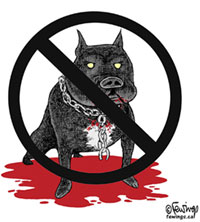 |
 |
 |
 |
A political cartoonist puts pen to the public's feelings: We don't want pit bulls in our neighborhood! And honestly, who in their right minds would feel comfortable around this dog? Note the rhetorical imagery employed here:
- Color of dog - black suggests evil, darkness
- Huge chest and head puts dog "in your face"
- Pointy ears resemble "devil horns"
- Broken chain implies super-strength
- Glowing yellow eyes
- Oh, and the huge pool of blood
|
A popular vending machine product portraying two Hispanic men restraining two pit bulls that are lunging at each other in a pose that obviously implies dog fighting. More than one stereotype is being suggested here, especially considering the race of the men (named "Mr. Pit" and "Big Loco").
On the artist's website, he writes this about "Mr. Pit": "His champion dog is called Perro Loco. People are always trying get Mr. Pit to fight Perro Loco, but he has decided to stop fighting him...even though he has never lost." Yet this toy "Mr. Pit" still apparently fights dogs, as his unexcusable pose suggests.
This toy is oriented toward young children.
|
Rapper DMX glorifies dog fighting in his music and displays highly stereotypical "vicious pit bull" imagery on several of his CD covers.
Note these stereotypical images on this CD cover:
- "Tough" facial expression (man)
- Looming dark-clothed figure (man) implies threat
- Several thick collars (dog) imply strength
- Baring teeth (dog) implies threat
- Background is a dark alley
|
President Bush once called Harriet Miers a "pit bull in size 6 shoes." Similar labels have been applied to public figures who are known for their tenacity or strong will.
However, the label may also imply that someone is a sort of "attack dog"—a person who seeks out or enjoys confrontation, who ignores or decimates opposing viewpoints, and/or who is insenstive to others.
|
The stereotypical or popular image of the pit bull is very different from the technical definition. The stereotypical pit bull is a human-aggressive, bloodthirsty, child-killing machine. It is impervious to pain, has locking jaws, and has incredible strength. It is highly unpredictable, unstable, and uncontrollable. Pit bulls are sometimes compared to sharks, tigers, venomous snakes, and other wild animals. There are a wide variety of myths associated with the stereotypical pit bull.
Some examples of individuals invoking the image of the stereotypical pit bull:
"They are a land shark. They are a walking time bomb...If something sets [a pit bull] off, it can kill. It wants to kill." - Oklahoma Rep. Paul Wesselhoft, Enid News, 7/28/05 |
"Repeat after me: 'This breed is unpredictable...prone to attack for no reason'." - Anonymous poster, discussing a July 12, 2007 Greely Tribune article entitled " Pit bull chases puppy into house" |
"...the pit bull is an exceptionally strong and athletic dog which requires extraordinary measures for confinement ( e.g., six-foot-high enclosed fences). Pit bulls... have been known to destroy sheetmetal panels by ripping them apart with their teeth." (Singer v. Cinncinnati, 1990, qtd in State of Ohio v. Anderson, 1991) |
|
"[Pit bulls'] massive skulls and powerful jaws give them almost super-canine biting power." - Brian C. Anderson, "Scared of Pit Bulls? You'd Better Be!," City Journal, Spring 1999. |
Popular images of pit bulls often pair this type of dog with a similarly frightening owner. Owners are typically characterized as drug dealers, gang members, or dangerous criminals. They are often described as uneducated, poor, "trailer trash." There is an element of racism that cannot be overlooked. In short, pit bull owners are as undesirable in a community as the pit bulls themselves.
Some examples of individuals invoking the image of the stereotypical pit bull owner:
"I can't help but believe part of the allure of owning a pit bull is the danger. If it's not, then why bother?" - Harry Smith, CBS Early Show co-anchor, 1/9/06 |
"We don't want 'those people' here." - Aurora City Councilmember Bob Fitzgerald, explaining the need for a ban on pit bulls |
"...those who go to shelters seeking out breeds like Pit Bulls have an agenda that goes beyond just having a family pet. They are looking for something that is linked to violence, something that is intimidating..." - Waterton, NY, Mayor Jeff Graham |
"Just a casual observation. About 98 percent of pit bull owners are certified 'White Trash'" - poster Tex06, Lone Star Times blog, 7/2/07 |
"Try to get homeowners' insurance with a pit bull (unless of course you lie about it, which would be about par for a pit bull owner). I doubt if a lot of pit bull owners can even afford a mortgage, though." - poster dezzzi on a Courier Press message board, 1/12/07 |
For some antisocial individuals, it is actually desirable to own a vicious dog. Individuals with low self esteem, who feel bullied or oppressed, or who crave attention, typically feed off of the intimidation and fear that an image of a stereotypical pit bull can stir up among the general populace. For this reason, the stereotypical pit bull can be a self-fulfilling prophecy, as those who are inclined to own a vicious dog are likely to do whatever they can to incite their dog to behave inappropriately.
Thus, people who "innocently" repeat and reinforce the stereotype, including those who repeat unsubstantiated rumors, and those who pass off mythology as fact, are partially responsible for the existence of vicious pit bulls. If the pit bull did not have such a strong stereotype, making it the "breed of choice" for irresponsible, dangerous owners, society would likely see a decrease not only in pit bull-related bites (and over-coverage in the media), but also in the number of criminals, thugs, and others who believe that a pit bull is the type of dog that will scare people, and consequently raise and train a pit bull to... what else? scare people.
Back to Table of Contents
Fad Breeders
Note: Because I do not want to provide free publicity to breeders—especially fad breeders—my source citations in this section will be rather vague. My apologies.
A "fad" breeder is generally defined as a person who breeds dogs to make money. Fad breeders surf the waves of popular demand and try to supply consumers with the latest "craze" in dog ownership. But fad breeders do more than just produce an overpopulation of a particular breed. To turn a profit quickly, fad breeders must disregard breed standard, health and temperament testing, and all other costly and time consuming measures that responsible breeders undertake to produce quality representatives of the breed.
Because fad breeders do not spend the time and effort to create a quality dog (one that meets breed standard and does not have health or temperament issues), and because they want a quick sale, fad breeders must market their substandard dogs in a way that makes the dogs seem better, more desirable, more unique, or "cooler" than properly-bred dogs. With pit bulls, fad breeders have redefined what "pit bull" means, and what traits are desirable in a "pit bull," in order to meet the market's demand for "badass" dogs.
Fad breeders often define and describe "pit bulls" closer to the stereotype than the true breed standard.
 This dog, according to a fad breeder, is a "pit bull." Compare it side-by-side with an American Pit Bull Terrier that meets breed standard. You will notice that, compared to a pit bull of correct conformation, this dog's This dog, according to a fad breeder, is a "pit bull." Compare it side-by-side with an American Pit Bull Terrier that meets breed standard. You will notice that, compared to a pit bull of correct conformation, this dog's
-
chest is too wide
-
head is too massive / cheeks too pronounced
-
jowls are too loose and hang down too far
-
legs are too short and bowed
-
muzzle is too short (leaning toward bracycephalic)
-
overall size is excessive
How can this dog, which is nothing like what a pit bull technically should look like, still be considered a "pit bull"? Yet, this particular "supersized pit bull" is usually the image that comes to the mind of people who use the stereotypical definition of pit bull. (Notice how this dog somewhat resembles the pit bull drawn by the political cartoonist, above.) |
The following is an ad that a fad breeder runs in Dog Fancy Magazine:
-
"Extreme large bone/head
-
Wide chest/hips
-
Powerful drive...
-
Males 90-130 lbs
-
Females 65-105 lbs"
Not a single one of these traits is desirable per breed standard for any of the pit bull breeds. The weight range alone is far outside appropriate weight for a true pit bull breed; calling these dogs "pit bulls" is like calling a 10 lb dog a Chihuahua. No matter how you look at it, Chihuahuas don't weigh 10 lbs. And pit bulls should not top 65 lbs, much less hit the triple digits! |
Another ad in Dog Fancy:
"'Size Does Matter'
Head, Shoulders and Chest above the Rest.
Females: 70-90 lbs.
Males: 90-100+ lbs.
Producing mid-size dogs with hard, rock-chiseled bodies."
Again, my objections to size as noted previously. These are not "mid-size dogs"; they are very large dogs—too large to be pit bulls in the technical sense. Further, "baseball cheek" is not a term I'm familiar with, but I'd assume the breeder is trying to stress the width of the dog's head and the extreme protuberance of its jaw muscles. Again, this is not what a real pit bull should look like. This is a caricature of a "musclebound" type of dog. In fact, this image is rhetorically reinforced by the use of the phrase "hard, rock-chiseled bodies." I picture a bodybuilder or weightlifter flexing his abs or crushing a soda can with his pectorals. |
Fad breeders of pit bulls will also emphasize guarding or protection abilities—never mind the prohibition against "viciousness" or human-aggression put forth by breed standards for pit bull breeds.
Indeed, it seems that fad breeders are capitalizing on some individuals' desire to be "bigger, better, and badder" than everyone else; thus, they portray the "pit bull" as the "bigger, better, and badder" accessory. Fad breeders market "pit bulls" as bulky, musclebound, powerful beasts that can be used for protection—or perhaps just to intimidate other people. This is a far cry from the technical definition of the pit bull that I put forth above, but not too far from stereotypical imagery.
Fad breeders are a major reason why the stereotype outshouts the technical definition of "pit bull."
Back to Table of Contents
Dog Fighters
"Countless centuries have been involved in developing the American Pit Bull Terrier into a fighting machine beyond comparison.... These dogs are downright 'bullet proof'!" —Richard Stratton, This is the American Pit Bull Terrier, 1976 |
"...the owner of one of the fighting breeds can enjoy the distinction of having—beyond a shadow of a doubt—the toughest dog on the block!" —Carl Semencic, The World of Fighting Dogs, 1984 |
"Not only does the Pit Bull love to fight, but he's very, very good at it and has unbelievable courage.... They also have a high threshold of pain... They are also very hard to kill.... Also, I have read somewhere—I don't know how reliable the source—that a Pit Bull has more than double the biting power of a German Shepherd, so when they do get vicious they can do more damage." —Bob Stevens, Dogs of Velvet and Steel, 1983 |
"...you can have one that peaks at only thirty pounds and still have a delightful animal that is all dog and, most assuredly, no sissy!... Two different people... have sent me pictures of Bulldogs doing battle with a wolverine—and whipping him! If the wolverine doesn't impress you, how about a lion?"—Richard Stratton, The Truth About the American Pit Bull Terrier, 1991 |
[Ed note: Naturally, the authors cited above claim that they are not involved in dog fighting. For obvious reasons, you won't find a lot of texts written by acknowledged dog fighters. However, the above authors—and many others—are very familiar with dog fighters and the dog fighting culture; they are the most accessible writers with texts in which dog fighters' voices may be heard; and they offer, and may even tout, the dog fighter's perspective. In this sense, their definition of "pit bull" is synonymous with the definition put forth by dog fighters.]
Since the activity began centuries ago, dog fighters have been talking tough about pit bulls. Without exception, dog fighters frame pit bulls as the ultimate "fighting machine." Machines, of course, lack the frailties, imperfections, and emotions that an animal possesses. Machines must be commanded to start and stop. In this way, the dog fighter de-humanizes (de-canine-izes?) the pit bull. The pit bull feels no pain, participates willingly, will not quit, and is unbeatably strong. The fighting dog has no flaws.
Why do dog fighters work so hard to build up the idea that pit bulls are the toughest, strongest dogs around? Why is it critical that pit bulls be presented as unbeatable and indomitable? One gets a sense, from reading the texts written by dog fighters, that the pit bull's status is tightly linked to the dog fighter's self-esteem. By owning an unbeatable dog, the owner feels superior to his peers.
Dog Fighters' Assertions |
Analysis of Assertions |
Pit bulls enjoy fighting and are willing participants in dog fights. |
This idea is used to support dog fighters' belief that pit fighting isn't cruel, or if it is, it is just as "cruel" as two humans fighting in a ring.
Unlike human fighters, pit bulls do not voluntarily sign up for fights—their owners make that decision.
Furthermore, one could argue that a fight to the death does not make the fight "enjoyable" to the participants; but it does make each dog desperate and determined to win, no matter what. Those "wagging tails" in the pit are not signs of joy; they are common indicators of stress and aggression. The "eagerness" with which a dog strains to get at another dog before the match has started is not due to a desire to "start the fun"; it is an eagerness to get the first bite, and have a chance to survive. |
Pound for pound, pit bulls are stronger than any other type of dog. |
There has never been any scientific evidence to prove this. Pit bulls do well in activities like weight pull, but so do many other types of dogs.
This is one of many baseless claims made by dog fighters to build up the reputation of the pit bull as a super-tough dog. |
Pit bulls do not feel pain, or are extremely tolerant of pain. |
There is no scientific evidence to support this. I personally know many pit bulls who are total wusses when it comes to pain.
In addition to using this as a means of casting the pit bull in the "super dog" frame, fighters also use this idea to justify the abusive practice of dog fighting. After all, if it doesn't hurt the dog, how can it be cruel? |
In most texts written by dog fighters, there is a very stereotypically masculine-oriented bent to the discussion. Richard Stratton, in particular, uses the word "man" almost exclusively when talking about dog fighters, and apparently assumes most of his readers are men (men who are amused by dog fighting). Further, many writers about pit dogs inevitably strive to "impress" (as Stratton says) their readers by spouting out story after story of dogs fighting each other, dogs fighting wild animals, and, occasionally, dogs acting aggressively toward people. These stories are written with overt admiration and amusement.
Because, in the dog fighter's mind, the only "real" dog is a supreme gladiator, it is natural that the dog fighter's definition of a pit bull revolves around the portrayal of the pit bull as an unbeatable fighting machine. Consequently, the dog fighter's definition of a pit bull is more of a stereotype than a reality.
It should be noted that the dog fighter's definition is also the definition from which many legal and social definitions sprout. BSL is passed, in part, because politicians and citizens buy into the dog fighter's emphasis that pit bulls are unstoppable (i.e. "bulletproof," "hard to kill," "can do more damage") and unbeatable. Courts have also cited dog fighters' exaggerated descriptions of the pit bull as evidence that the dogs are dangerous (see, for example, State of Ohio v. Anderson, 1991). This, of course, only legitimizes the dog fighter's stereotype, thereby encouraging dog fighters—and others who wish to own "the toughest dog on the block"—to go out and get a pit bull not as a pet, but as a status symbol.
Back to Table of Contents
Pit Bull Owners
The definition of "pit bull" is not at all consistent among their owners. Furthermore, any owner's definition may evolve over time based on their experiences and gained knowledge about the breed-type.
Type 1—Tough dog
Novice owners' early definition of pit bull typically parallels popular imagery or the dog fighters' stereotype. This is due to these images' immediacy and prevalence, as well as the novice owner's limited experience and knowledge. Many first-time pit bull owners are easily able to obtain Richard Stratton's books, wherein the pit bull is described as a tough fighting machine. Jacqueline O'Neal's or Diane Jessup's books, wherein the pit bull is greatly normalized and the author puts forward a strong image of pit bulls-as-pets, can be more difficult to find. Furthermore, novice owners tend to receive a great deal of feedback from inexperienced friends and family members who define pit bulls via media horror stories and popular imagery.
For those owners who aquired their pit bull as a status symbol and intimidation device, this definition may be quite agreeable. Therefore, they may never revise the definition past this point.
Thus, owners may define pit bulls as
-
Very tough dogs
-
Unbeatable dogs
-
Aggressive dogs
-
Dogs with a fighting nature
-
"Badass" dogs
-
Potentially dangerous dogs
-
Backyard dogs, guard dogs, money-making dogs—not pets or family members
Type 2—Perfect angel
Owners who are uncomfortable with the Type 1 definition, and who see an extreme disjoint between this and the definition that their own pit bull—usually a puppy—seems to be offering (friendly, gentle, sweet, funny, playful, etc.) will totally reject the former definition. They redefine the pit bull as a total angel, incapable of doing wrong. Common quotes by pit bull owners who use the Type 2 definition include: "He wouldn't hurt a fly," "My dog is the sweetest dog ever," "Not an aggressive bone in his body," "I trust him completely with my kids," "Perfect in every way," and so on.
Many owners therefore see pit bulls as
-
Sweet, loving, friendly dogs
-
Dogs that must be taught or trained to be mean
-
Dogs that would not hurt a flea
-
Human-like entities, capable of highly rational thought and deep emotions
-
Super-dogs possessing abilities that outpace those of any other type of dog
Note: This sort of attitude is definitely not limited to pit bull owners; this can apply to an owner of any breed of dog.
Type 3—Normal dog
More experienced and educated owners, having been exposed to a wider variety of material and points of view, generally reject both Type 1 and Type 2 definitions in favor of a more moderate definition. They see the pit bull as a normal dog, with typical canine needs, flaws, and abilities. Responsibilities and requirements for ownership are the same as with any other type of dog. It is generally understood that the pit bull is neither an innocent angel nor a vicious beast; the pit bull is a dog and will behave like a dog.
These owners define the pit bull as
-
A dog, possessing the good and bad qualities of a dog
-
A companion and a family member—definitively canine, but nevertheless a beloved pet
-
A living creature with behaviors stemming from both genetic and environmental factors
-
A dog that can do everything other dogs can do—no more or less











 Literally, the term "pit bull terrier" (from which comes the shortened term "pit bull") can be broken down into three components: "pit," "bull," and "terrier." "Pit" acknowledges the dog's history as a fighting dog (because dogs fight in "pits") while "bull" highlights the dog's bulldog ancestry and "terrier" describes the dog's terrier ancestry (see the graph and history section above). It is important to note that not every fighting dog is a Bull-and-Terrier, and not every Bull-and-Terrier is a fighting dog. The three elements (Bulldog, Terrier, fighting dog) come together only in the pit bull type dog.
Literally, the term "pit bull terrier" (from which comes the shortened term "pit bull") can be broken down into three components: "pit," "bull," and "terrier." "Pit" acknowledges the dog's history as a fighting dog (because dogs fight in "pits") while "bull" highlights the dog's bulldog ancestry and "terrier" describes the dog's terrier ancestry (see the graph and history section above). It is important to note that not every fighting dog is a Bull-and-Terrier, and not every Bull-and-Terrier is a fighting dog. The three elements (Bulldog, Terrier, fighting dog) come together only in the pit bull type dog.




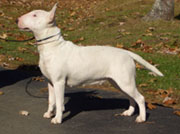
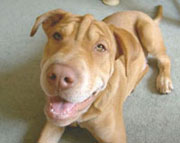




 This dog, according to a fad breeder, is a "pit bull."
This dog, according to a fad breeder, is a "pit bull."